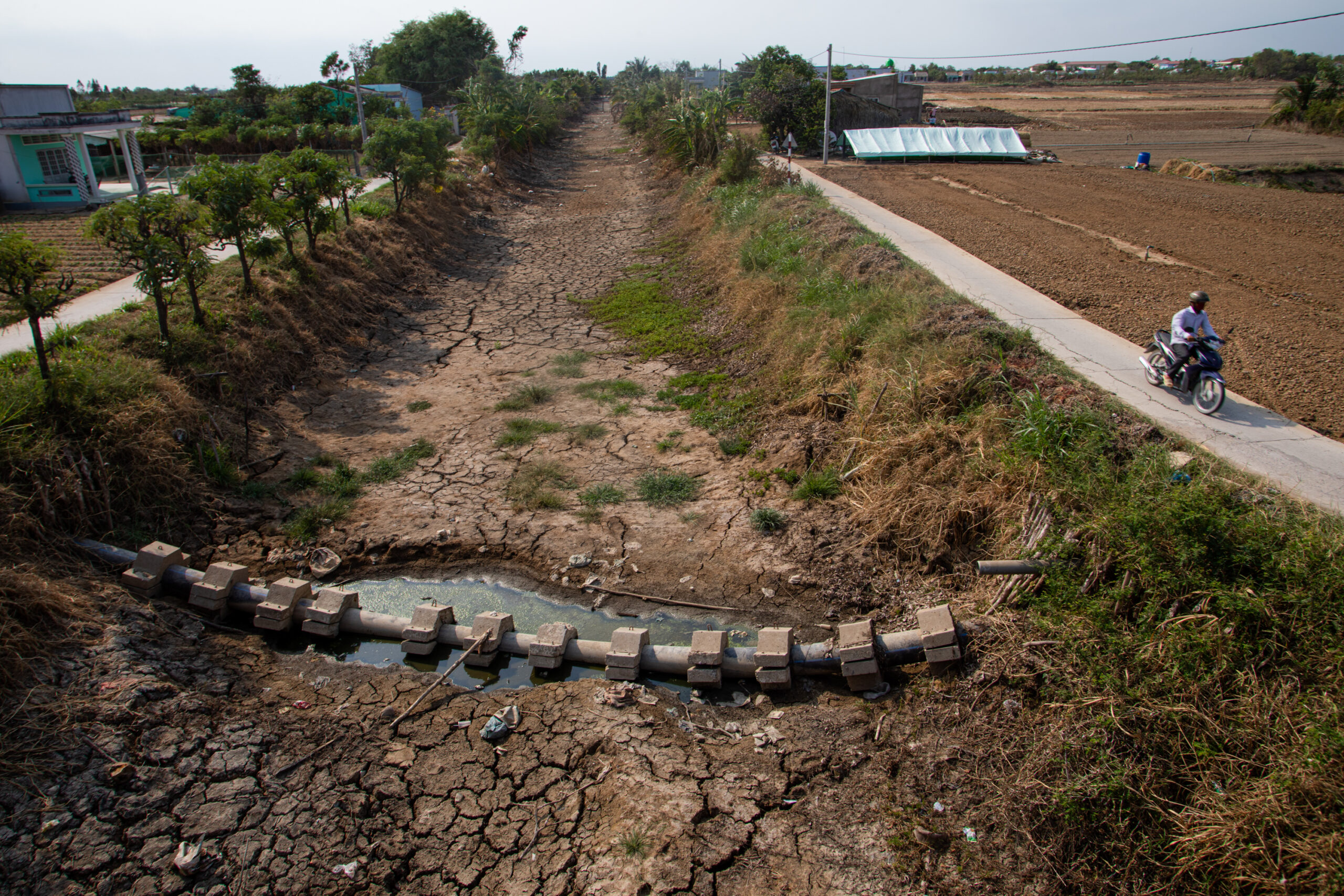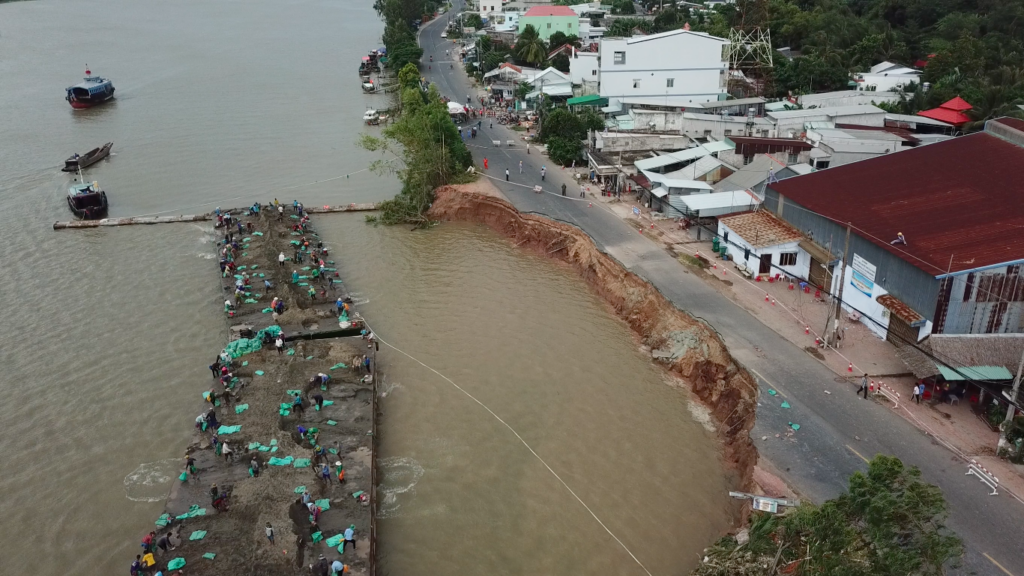HO CHI MINH CITY, VIETNAM – At 63, Nguyen Thi Ngoc landed her first full-time ‘company’ job as a security guard in Ho Chi Minh City. She had never been to a city before taking the job in early 2021, but the former farmer from the Mekong Delta in southern Vietnam was indifferent to the urban bustle of the country’s largest city.
“I came here to work, make some money, not to play around,” she said, while sitting outside the semi-abandoned housing complex she guarded. “In the past six months, the only place I have visited is the market.”
About six years ago, Ngoc and her husband gave up their farm in Tien Giang province, on the Mekong Delta. Faced with increasing saltwater intrusion, they switched from growing rice to cultivating more salt-tolerant pineapples. But even this was not enough.
Yields had been falling for a few seasons, then in 2016 the water in their local canals – which connected with the Mekong River – became so salty that even the pineapple plants could not cope, and they stopped bearing fruit.

That year, Vietnam’s Mekong Delta region was hit by drought, leaving 600,000 people without access to fresh water. Below average rainfall, driven by that year’s El Niño, and upstream hydropower dams on the Mekong trapping the river’s water, were identified as the main causes of the drought.
The reduced water flow meant the river was less able to push back sea water, allowing salt water to penetrate deep inland, paralyzing the coastal agriculture hub and causing direct economic losses of US$319.5 million.
Disheartened, Ngoc’s husband sold the land to cover their losses and moved to Ho Chi Minh City to take up a job as a security guard. Five years later, in early 2021, she followed.
“I didn’t want to burden my son and daughter. Both were already poor and had their own families,” she said.
The Mekong Delta blues
With its storm-free weather and fertile soil, Vietnam’s Mekong Delta was traditionally known as a region of plenty: only 17 million people lived in the region, but it fed much of Vietnam’s population of 100 million, producing more than half of all rice produced in the country.
However, since 2009, the Delta has become one of the few places in the country where the population has shrunk. Deteriorating agricultural land, water shortages, landslides and pollution have led to nearly 1.1 million people – the equivalent to the population of an entire province – to migrate out of the region.
The historic drought of 2016 was only part of an emerging pattern in the Mekong Delta. Its annual flood pulse, which the region’s agriculture and aquaculture have traditionally relied on, has become increasingly unpredictable.
In the past two decades, El Niño and La Niña have swung the delta between unusually dry and wet extremes, causing multiple droughts and floods.
With an estimated average elevation of only 80cm, the Mekong Delta is extremely vulnerable to the impacts of rising sea levels, which could include the inundation of large areas, more severe salinity intrusion and coastal erosion of the low lying land.

On top of climate change, other human activities have irreversibly transformed the region.
Over the last two and a half decades, dams have been constructed on the Mekong’s mainstream, with 11 dams on China’s section of the Mekong (known as the Lancang) and two in Laos, with seven more in various stages of planning along the mainstream.
Many dams have also been built on the Mekong’s tributaries. This has caused the river to lose much-needed water and sediment, driving severe erosion, which has been exacerbated by sand mining.
Meanwhile, subsidence driven by groundwater extraction is expected to worsen the flooding, saltwater intrusion and erosion.
“[These problems] have made farming a very risky business in the delta,” said Phung Duc Tung, the director of the Mekong Development Research Institute, a leading independent research institute in Vietnam.
In the Mekong Delta, sand mining means lost homes and fortunes
Known as the rice basket of the country, the delta now sees houses tumbling into rivers and livelihoods lost.
Migration as a coping strategy
“Seniors being driven out of villages to make a living in cities is a concerning issue that needs more study,” Tung said. The most recent national survey on internal migration, from 2015, noted a marked increase in the proportion of migrants in the 50-59 age group between 2004 and 2015, rising from 2.9% to 5.7%.
The 2011 Vietnam Aging Survey found that nearly 40% of people over 60 were still working, predominantly those from rural areas with little access to financial support from social benefit systems. The fewer children they had to receive support from, the more likely they were to continue working.
According to Vietnam’s Ministry of Labor, Invalids and Social Affairs, by the end of 2020, only 35% of people above the retirement age (60 for men and 55 for women) were entitled to pensions and monthly social insurance allowances. Entitlement depends on having worked in the formal sector and paying national insurance contributions.
Migration is traditionally not a common choice for older rural Vietnamese people, Tung said. They generally do not want to go to the city, with its fiercely competitive workforce and busy lifestyle, which they are ill-prepared for.
But when their livelihoods in their home towns can no longer guarantee their minimum subsistence, and without the support of children, they have to migrate, he said. For them, migration is a coping strategy.
In the Mekong Delta, where non-farm jobs are rare, any severe blow to agricultural production results in landlessness and joblessness, Phung explained. “The fact that Vietnam’s social safety net and pension barely cover the population definitely plays a part here.”
The occupational transition can be especially hard for older migrants, including older farmers, who may possess few transferrable skills and low education levels, Tung said.
Older people who migrate to the city tend to be employed in the informal sector, as construction workers, vendors, cleaners, housekeepers and security staff.
Troubles upstream
This was the experience of Tu Day and her husband. Moving to Ho Chi Minh City six years ago from the Mekong Delta province of Dong Thap was the “last resort,” said the 58-year-old, who cuts grass and sweeps leaves in a park for a living. Her husband, who is five years older, works in construction.
Back home in Dong Thap, upstream of Tien Giang, Tu Day and her family had to deal with a different set of problems from Ngoc and her husband. For years, their fish farm had been under constant threat from increasingly polluted river water and recent “crazy” heavy rain, she said.
The river water became full of garbage, fish-pond sewage and pesticides, she said, making it risky to pump onto their farm. “The fish [would] get sick and die only days before we could sell them,” she said.
In 2016, the year her family finally gave up, a mass fish death hit their district. Local authorities blamed climate change for having lowered river levels, causing “adverse affects” on aquaculture.

Tu Day’s family had plunged into debt. The couple sold the land they had farmed rice on, but that only covered part of the debt. While their son and daughter stayed behind to work what remained of their fish farm, Tu Day and her husband headed to Ho Chi Minh City.
Yet six years later, the debts linger. Tu Day said she had become sick more often since moving, leading to costly hospital bills. Her husband complained of feeling “suffocated” in the narrow room they rent in a building they say is “full of country old folks like us.”
‘It’s like looking at the future’
“In a sense, they [older working migrants] are forced laborers who are extremely vulnerable,” said Giang Thanh Long, director of the Institute of Public Policy and Management at the National Economics University in Hanoi.
Manual work exposes older migrants to occupational injuries and accidents, but unlike the young, they are more likely to have chronic illnesses, which are worsened by poor diets and accommodation.
With no health insurance and no labor protection, “they are caught in a vicious circle,” said Giang.
According to Hang Ngo, a public health research scientist whose recent work focused on migration from the Mekong Delta to Ho Chi Minh City, migration rarely reduces vulnerabilities related to socio-economic and climate stressors, but is “more like a shift from one set of climate risks and health-related vulnerabilities to another.”
The phenomenon is likely to grow in years to come. Vietnam is one of the fastest-aging countries in the world. With 25% of its population projected to be over 60 by 2049, it is “getting old before getting rich,” according to the World Bank.
Meanwhile, the conditions which led Tu Day and Ngoc to migrate in 2016 were only the start. The Mekong Delta has since been struck by even more severe droughts and saline intrusion events in 2020 and 2021.
But a more inclusive climate response strategy could help address many of the problems that push older migrants away in the first place, said Tung and Hang.
For instance, agriculture livelihood diversification programs could do more than focusing on resilient crops or farming techniques for farmers, and start channeling more support to those who are landless and lack access to financial resources, Hang explained.
And if people decided to go to the cities, she added, development and climate adaptation policies should cover their needs and protection to reduce urban precarity.
The Covid-19 pandemic highlighted the thin social protections for migrants in Vietnam. Many migrants were reportedly stuck in crowded rentals, facing increased risk of infection.
“While everyone was at risk, vulnerable people like migrants were most affected,” said Hang. Having a better safety net and more social protections could help these groups to recover from crises, she added. “If either a pandemic hits or climate change amplifies, people will be able to adapt better.”
“It is like looking at the future,” Tung said. “The problems this group are dealing with today will be the problems many others have to deal with in the coming years. Building protection policies for them is, in fact, working towards a better future for all of us.”
Even as many migrants left Ho Chi Minh City in late 2021, Tu Day and her husband decided to stay to pay their remaining debts.
“There is nothing for us back home, no money to spend, no rice to eat – we’d die of hunger,” she said. “Plus, home is sad now; my village has become deserted. Our neighbors have also left for the city.”
Vo Kieu Bao Uyen contributed to this report.
Reporting for this story was supported by Internews’ Earth Journalism Network. It was originally published by The Third Pole on October 24, 2022.






